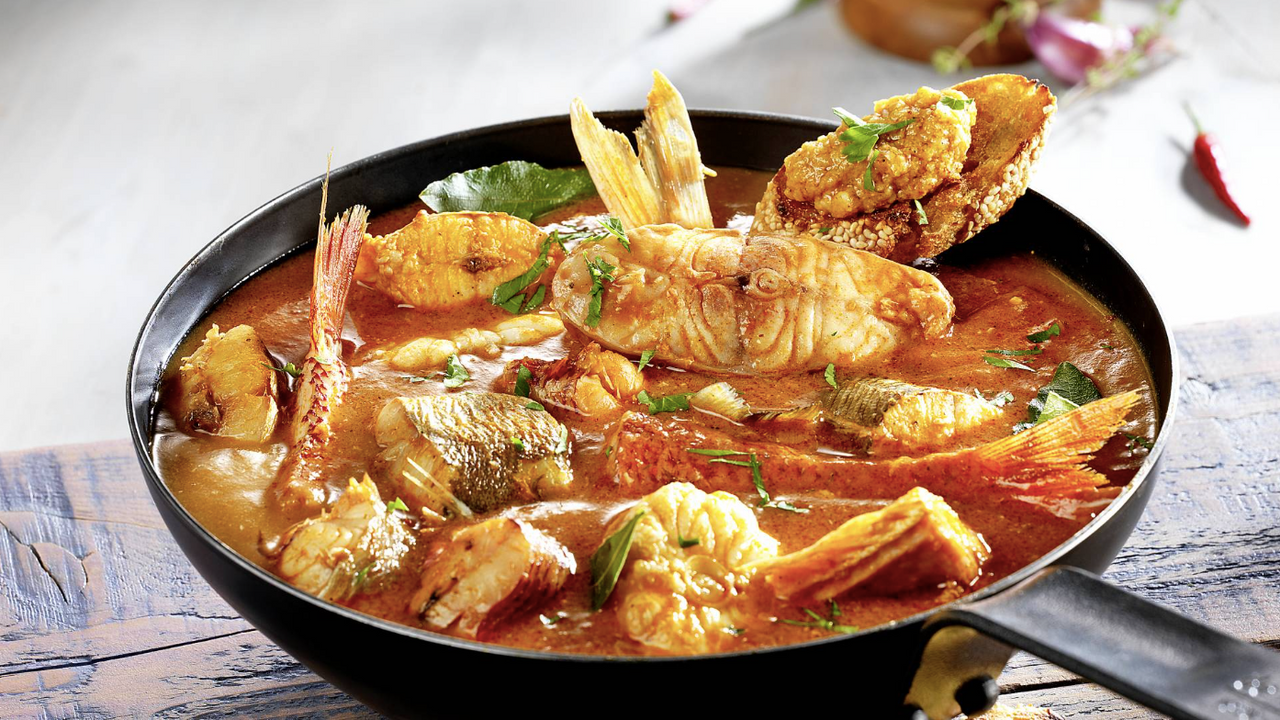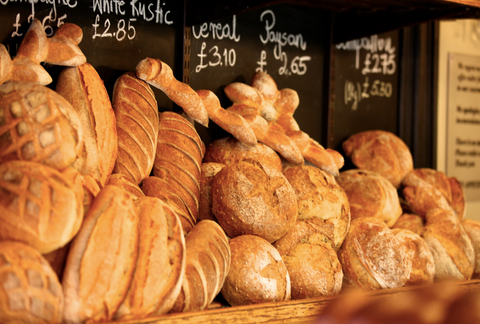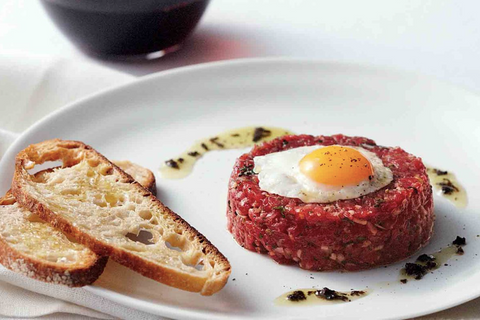What is a Bouillabaisse?
Bouillabaisse is a fish stew originating from the Provence region of France. It has a rich history and flavor, with origins in the 19th century. The name comes from the French verb bouillir, which means to boil, and abaisser, to reduce heat.
Bouillabaisse is a soup, a seafood stew made with fresh fish, garlic cloves, olive oil, and saffron. It is a specialty of Marseille. The name bouillabaisse comes from the French words bouillon (broth) and abaisser (to reduce). In other terms, it means "simmer down."
A real bouillabaisse must include at least 3 kinds of fresh fish:
- Rascasse (rockfish) or scorpionfish,
- Congre (eel), and
- Grondin (gurnard). Other types of fish can be added to the mix.
Traditionally, the chef simmers the broth for several hours and then adds the fish and other ingredients just before serving as given in bbcgoodfood. When ready to serve, each bowl is topped with a rouille. Rouille is a spicy mayonnaise-like sauce made with garlic and chili pepper.
Sauces for Bouillabaisse
What is bouillabaisse sauce made of? Here are tips and recipes to make this classic Provençal fish soup at home.
What is Bouillabaisse Sauce?
- Bouillabaisse is a rich fish stew that originated in the French port city of Marseille on the Mediterranean coast. The traditional preparation includes several different types of fish and shellfish, typically including rascasse (scorpionfish), sea robin, European conger, handles such as leeks, onions, tomatoes, celery, and celerytatoes.
It is typically made with at least three different kinds of fish and shellfish, along with herbs and spices. Bouillabaisse is served with bread and rouille sauce.
- Rouille is a traditional Provençal sauce made with red peppers, olive oil, garlic, saffron, and breadcrumbs. It's similar to aioli in texture but has a much stronger flavor.
Bouillabaisse takes long process to complete
The traditional way to make bouillabaisse involves two days, a handful of ingredients,
- There are two ways to make bouillabaisse, at least according to the French: the Marseillaise and the Provençal way. Both start with a broth made from fish and shellfish, but the Marseillaise version uses a variety of fish, while in Provence, it's usually just one or two species. The Provençal version is also much more likely to include saffron and tomatoes.
- The key difference between them is when you add the fish. In Marseille, they are added at the end, while in Provence, they are cooked in the broth for several hours. This means that you can have a good bouillabaisse on the day you start making it – even if your fishmonger has run out of fresh stock and you have to use frozen mussels as I did – but for an exceptional bouillabaisse, you need to wait overnight.
Taste of Bouillabaisse
According to simplyrecipes Bouillabaisse is a traditional French soup made of various fresh fish and seafood varieties in a broth of tomatoes and aromatic vegetables.
The broth is typically served by itself with croutons and rouille, a mayonnaise-like sauce made with olive oil, egg yolks, garlic, saffron, and cayenne pepper. The seafood is then served separately from the broth.
What do you eat with Bouillabaisse?
The traditional accompaniment to bouillabaisse is toasted baguette slices dipped into the broth and fish. The bread should be lightly rubbed with cut garlic and drizzled with olive oil.
A bouillabaisse will typically contain any or all of the following ingredients:
- Seafood such as mussels, clams, whelks, lobster, prawns, king prawns, scallops, squid, cuttlefish, and monkfish
- Fish such as sea bass or red mullet
- Provençal vegetables such as tomatoes, fennel, leeks, and garlic
- Herbs such as saffron, bay leaves, and fennel, plus a pinch of dried chili flakes
- One or more spices, including cumin seed and coriander seed
- You can also add potatoes to your bouillabaisse if you want to bulk it out a bit.
Difference between Cioppino and Bouillabaisse
- Cioppino and bouillabaisse are both similar in what they are and how they're made. But there are some key differences to know before you put one on your menu over the other.
- Cioppino and bouillabaisse are Italian and French seafood stews with a tomato base. The main difference is that cioppino originates from San Francisco, while bouillabaisse is from Marseille, France.
- Traditionally, bouillabaisse uses fish stock as its base, but most modern versions use tomato broth instead. Cioppino also uses a tomato broth — which is why it's sometimes called an Italian-American soup — but the ingredients vary by chef and restaurant. Cioppino and bouillabaisse include fish, shellfish, saffron or fennel for flavor, and olive oil for richness.
Wine which goes with Bouillabaisse
The short answer is a white Rhone wine, but many other choices, including different regions and red wines.
Before we get into the nitty-gritty of wine and food pairing, it's important to understand what the word "goes" means in this context. What wine "goes" with bouillabaisse doesn't mean that you can't drink another type of wine with your stew — you can, and many people do? But when looking for a recommendation for the best wine to pair with bouillabaisse (or any dish), we're asking for a wine that will complement the dish's flavors.
A glass of white Rhone wine is a traditional pairing for the bouillabaisse as given in decanter website.

Here are a few wines that will pair nicely with bouillabaisse:
- White Châteauneuf-du-Pape: The grapes used to make this famous Rhône Valley white wines are Grenache Blanc and Roussanne, making for a robust wine full of tropical fruit flavors. The alcohol content is also high (14 percent), but it's balanced by rich acidity and minerality. If you can't find a Châteauneuf-du-Pape to drink with your bouillabaisse, any dry white Rhône Valley wine is also a good choice.
- Whites and rosés from Bandol: The wines of Bandol in Provence have more structure than other Provençal wines, making them ideal for pairing with the richness of bouillabaisse.
Bouillabaisse is served hot or cold?
According to the Larousse Gastronomique, bouillabaisse is a soup that is served hot. However, in Provence, there are two soups known as bouillabaisse. The first one is a simple fish stew that is served hot. The second type of soup, known as bouillabaisse from Provence, is raw fish and shellfish. This second type of bouillabaisse was created by the fishers who could not cook their catch. Therefore, the fishers would eat this cold soup for breakfast or lunch.
Bouillabaisse is a classic French fish stew traditionally served in two courses.
First come soup, made by simmering assorted fish and shellfish in a saffron-infused broth that's thickened with a purée of breadcrumbs and tomatoes. The soup is served hot with a rouille, a type of garlicky aioli sauce, either spread on croutons or mixed into the soup.
Next come fish, which is taken from the pot and served whole. The broth may be reserved to use as a dipping sauce or mopped up with bread.
Bouillabaisse is most often eaten as an appetizer followed by another dish, such as lamb or chicken, but it can also be made large enough for one person's entire meal.
Does Bouillabaisse have wine in it?
This is a very good question. The broth of a bouillabaisse should be perfumed, not overpowered, with white wine. It should also have saffron and orange zest in it – and will almost certainly have garlic and fennel.
- In Marseille, where bouillabaisse originates, they use a particular fish called rascasse (also known as scorpionfish) to make the broth. This is widely believed to be necessary for the authentic dish, though some say you can produce an equally good result with monkfish or red mullet.
- In any case, the fish should be cooked whole in the broth – and may then be served on the side to eat.
Serving the Bouillabaisse
Throughout the Mediterranean, bouillabaisse is a dish made with local ingredients and cooked in different ways in various regions. But it is most commonly associated with Marseille, France. Shellfish such as mussels and crayfish are also common additions.
- The traditional preparation begins with sautéing onions in olive oil, then adding garlic and tomato before adding broth or water.
- Next, the fish and shellfish are added to the pot and brought to a boil. When the dish is ready to serve, rouille — a mayonnaise-like sauce made from olive oil, breadcrumbs, saffron, egg yolks, and cayenne — is spread on slices of French bread and placed on each bowl of soup to float on top.
Main component in a Bouillabaisse
It's a French fish stew. The name comes from two French words: bouillir, meaning "to boil," and abaisser, meaning "to lower."
The dish is thought to have originated in Marseille, a port city on the Mediterranean coast of southern France. Local fishers created it to use up the bony rockfish that couldn't be sold at the market. They combined the fish with onions, garlic, tomatoes, and saffron. Today a shellfish like lobster might also be added.
Other parts of France have their versions of bouillabaisse that include different fish and spices. Some chefs even make a vegetarian version using potatoes, leeks, and fennel in place of the fish!
How to Thicken Bouillabaisse?
Before you thicken your bouillabaisse, make sure that you've cooked the soup for a long enough periods. If you cut the cooking time short, it will not be as flavorful or rich.
- To thicken your bouillabaisse, remove the fish and shellfish from the broth and set them aside. Reduce the heat to medium and stir in 1 tablespoon of cornstarch. Will this further:
- Stirring in a small amount of flour is another way to thicken your soup. Use about 1 tablespoon (14 grams) of flour for every cup (237 ml) of bouillabaisse. Put the flour in a small bowl and slowly whisk in water until you create a smooth paste. Then, pour it into the pot with the soup and cook everything over medium heat until it simmers.
Reheating Bouillabaisse
You've just slurped down a bowl of fresh, steaming bouillabaisse, and a few hours later, your stomach starts to rumble. You're hungry again, but what should you do with the leftover bouillabaisse? How do you reheat it, so it still retains that beautiful orange color and seafood flavor?
- Reheating leftover bouillabaisse can be tricky if you don't know what you're doing. So here are three tips on how to heat your leftover bouillabaisse:
- Don't microwave it. The microwave is not your friend when reheating bouillabaisse. Not only will the seafood turn rubbery and lose its flavor, but the broth will become watery and bland. The microwave is great for reheating pizza, but not bouillabaisse.
- Boil it in a pot. A pot is perfect for reheating bouillabaisse because it simmers the stew at low temperatures without drying out the seafood or burning the broth. Place your leftover bouillabaisse into a pot and bring to a boil over medium heat, occasionally stirring for about five minutes or until warm.
- Use an oven-safe bowl covered in aluminum foil. If you have an oven-safe
How long can you keep Bouillabaisse?
You can keep bouillabaisse for about three to four days in the refrigerator. Better yet, make it a day ahead of time and let it sit overnight to allow the flavors to develop.
- Bouillabaisse is a French seafood stew usually served with fish and shellfish. Bouillabaisse is traditionally made with Mediterranean saffron, infusing the hash with a unique golden sheen and rich flavor. You can use bouillabaisse as a guide when choosing saffron — if it isn't yellow or doesn't have a strong flavor, you need to replace it.
While bouillabaisse is classically served at room temperature, the broth should still be hot, and the fish should be cooked all the way through before serving. When stored properly, bouillabaisse usually lasts for three to four days in the refrigerator.
Eating Seafood Bouillabaisse
Seafood bouillabaisse is a traditional Provençal fish stew originating from the port city of Marseille. The French trick to eating bouillabaisse is to eat it in two courses. First, you eat the soup, and then you eat the seafood. If you are unfamiliar with eating bouillabaisse, here's a step-by-step guide:
Step 1: Remove your fish from the broth and place it on a plate for later.
Step 2: Taste the broth, add salt if needed, and then enjoy it with a piece of baguette.
Step 3: Once finished with the broth, remove the heads from your fish and fish bones from the tail. Then pull out all the meat and eat it!




